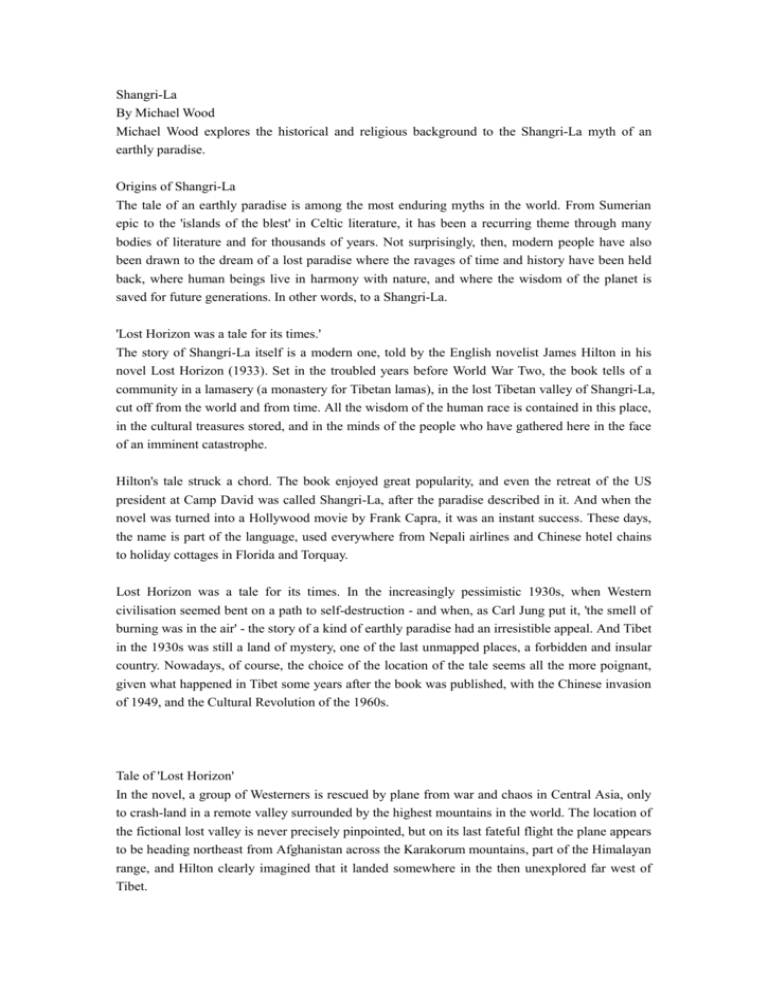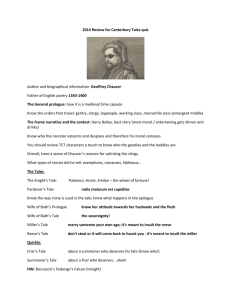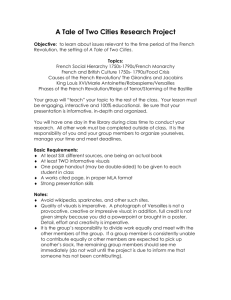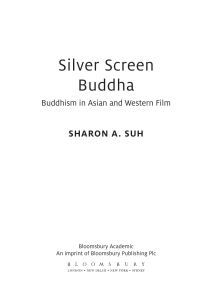Shangri-La
advertisement

Shangri-La By Michael Wood Michael Wood explores the historical and religious background to the Shangri-La myth of an earthly paradise. Origins of Shangri-La The tale of an earthly paradise is among the most enduring myths in the world. From Sumerian epic to the 'islands of the blest' in Celtic literature, it has been a recurring theme through many bodies of literature and for thousands of years. Not surprisingly, then, modern people have also been drawn to the dream of a lost paradise where the ravages of time and history have been held back, where human beings live in harmony with nature, and where the wisdom of the planet is saved for future generations. In other words, to a Shangri-La. 'Lost Horizon was a tale for its times.' The story of Shangri-La itself is a modern one, told by the English novelist James Hilton in his novel Lost Horizon (1933). Set in the troubled years before World War Two, the book tells of a community in a lamasery (a monastery for Tibetan lamas), in the lost Tibetan valley of Shangri-La, cut off from the world and from time. All the wisdom of the human race is contained in this place, in the cultural treasures stored, and in the minds of the people who have gathered here in the face of an imminent catastrophe. Hilton's tale struck a chord. The book enjoyed great popularity, and even the retreat of the US president at Camp David was called Shangri-La, after the paradise described in it. And when the novel was turned into a Hollywood movie by Frank Capra, it was an instant success. These days, the name is part of the language, used everywhere from Nepali airlines and Chinese hotel chains to holiday cottages in Florida and Torquay. Lost Horizon was a tale for its times. In the increasingly pessimistic 1930s, when Western civilisation seemed bent on a path to self-destruction - and when, as Carl Jung put it, 'the smell of burning was in the air' - the story of a kind of earthly paradise had an irresistible appeal. And Tibet in the 1930s was still a land of mystery, one of the last unmapped places, a forbidden and insular country. Nowadays, of course, the choice of the location of the tale seems all the more poignant, given what happened in Tibet some years after the book was published, with the Chinese invasion of 1949, and the Cultural Revolution of the 1960s. Tale of 'Lost Horizon' In the novel, a group of Westerners is rescued by plane from war and chaos in Central Asia, only to crash-land in a remote valley surrounded by the highest mountains in the world. The location of the fictional lost valley is never precisely pinpointed, but on its last fateful flight the plane appears to be heading northeast from Afghanistan across the Karakorum mountains, part of the Himalayan range, and Hilton clearly imagined that it landed somewhere in the then unexplored far west of Tibet. 'It was a repository of all the cultural treasures of the planet, and its inhabitants were opposed to all violence and materialism.' He tells us that in the valley there was a lamasery, headed by a 200-year-old Capuchin lama. It was a repository of all the cultural treasures of the planet, and its inhabitants were opposed to all violence and materialism. This lamasery stood in the shadow of a magnificent white mountain, 'the loveliest mountain on earth ... an almost perfect cone of snow, a dazzling pyramid so radiant, so serenely poised that it scarcely seemed to be real'. But on what older tale was this exotic story based? Did Hilton have an actual place in mind? Was there indeed a real Shangri-La? And why does the myth of an earthly paradise seem to have such a hold on the human imagination? Andrade's tale The tale of a lost kingdom in the region of the Tibetan mountains first came to Western attention nearly four centuries ago. And like many a tale of hidden treasure, it starts with a mysterious map this one lost, then rediscovered a hundred years ago in Calcutta. It was part of a remarkable manuscript that contained the autobiography of a 16th-century Western missionary at the court of the Moghul emperor Akbar. At Akbar's time India still reigned glorious at the centre of the civilised world, but the winds were changing and the great power of Asian lands was just beginning to reduce, under pressure from the modernity of Europe. In partial response to this shifting world, Akbar gathered scholars of all races around him, hoping to find the common basis of all religions, in order to remove the sources of religious conflict for the good of humankind. As he put it: It now becomes clear ... that it cannot be right to assert the truth of one faith above any other ... In this way we may perhaps again open the door whose key has been lost. Thus in his court congregated Hindus, Yogis and Sadhus from all corners of his empire, as well as visiting Christian monks and pilgrims from western lands. This was the moment when Westerners first heard accounts of what lay beyond the Himalayan mountains, the very first time that Tibet entered the consciousness of Europeans. One visiting Jesuit priest summarised the strange stories he heard at the court of Akbar in an essay, and sketched an accompanying map. On his map the area of Tibet is depicted as a great white blank, except for one place, labelled 'Manasarovar lacus' (Lake Manasarovar), with next to it a tantalising scribbled note saying, 'Here it is said Christians live'. The priest who penned the map was old, and incapable of undertaking a dangerous mission across high mountain passes in search of an obscure community of Christians. But his successor, a Portuguese Jesuit missionary named Antonio Andrade, was galvanised by the tale, and determined to go in search of these people. Andrade set out from Akbar's court, armed with the map, and at first followed yogis and wandering pilgrims on the road across the mountains. The terrain soon became hostile, but Andrade did eventually find an impressive and wealthy kingdom - although no Christians lived there - and his account of his adventurous journey was rediscovered in Calcutta in the 19th century. It was republished in 1926 under the title Discovery of Tibet, and Hilton's Lost Horizon obviously owes much to this work. Shambala This idea of a lost kingdom somewhere in the Himalayas has also circulated in Tibetan Buddhist teaching for centuries, and may well itself have been told at the court of Akbar. The name Shambala first appears in a text known as the Kalachakra tantra - or Wheel of Time teaching. The Kalachakra doctrine belongs to the highest level of Buddhist Mahayana teaching, and those who follow it can reach enlightenment in just a number of years rather than a whole lifetime. In this doctrine, the place named Shambala appears as a mystical conception, a spiritual rather than a geographical goal. (Curiously, although the tale is known now as a Tibetan myth, it seems that it was first recorded in AD 966 in India.) The Buddhist Kalachakra tale tells of a land behind the Himalayas, ruled by a gracious King Sucandra, who was the first to learn the Kalachakra doctrine from Buddha Sakyamuni himself. In Shambala, the people lived in peace and harmony, faithful to the principles of Buddhism, and the concepts of war and sorrow were unknown. Shambala is a magic land, unlike any place on earth, and rests in the shadow of a magnificent white mountain. As one commentator on the Kalachakra tantra puts it: The land of Shambala lies in a valley. It is only approachable through a ring of snow peaks like the petals of a lotus ... At the centre is a nine-storey crystal mountain which stands over a sacred lake, and a palace adorned with lapis, coral, gems and pearls. Shambala is a kingdom where humanity's wisdom is spared from the destructions and corruptions of time and history, ready to save the world in its hour of need. The prophecy of Shambala states that each of its 32 kings will rule for 100 years. As their reigns pass, conditions in the outside world will deteriorate. Men will become obsessed with war and pursue power for its own sake and materialism will triumph over all spiritual life. Eventually an evil tyrant will emerge to oppress the earth in a despotic reign of terror. But just when the world seems on the brink of total downfall and destruction, the mists will lift to reveal the icy mountains of Shambala. Then the 32nd king of Shambala, Rudra Cakrin, will lead a mighty army against the tyrant and his supporters and in a last great battle, they will be destroyed and peace restored. Shangri-La today As we have seen, the tale of Shangri-La is a modern tale, with a powerful appeal for today's world - but its roots lie deep in much older times. We live in a period when global problems threaten to overwhelm us, and instil us with fear. The appeal of the tales of Shambala and Shangri-La lies in their connection with this fear - both recognising it and alleviating it - and this appeal is universal. The stories reflect our desire that something of our world will survive, and that our connection with our past will not be entirely erased, even as we move faster and faster into an uncertain future. These are tales that we still need to believe in today. Find out more Books Lost Horizons by James Hilton (Bt Bound, 1999) Early Jesuit Travellers in Central Asia 1603-1721 by C Wessels (Book Faith India, 2002) Tibet Handbook by Gyurme Dorje (Footprint Books, 1999) The Way of the White Clouds by Lama Govinda (Hutchinson, 1966) Tibet in Pictures by Li Gotami Govinda (Dharma Publishing, 1979) A Mountain in Tibet by Charles Allen (Abacus, 1982) The Search for Shangri-La, 1999 by Charles Allen (Abacus, 1999) The Way to Shambala by Edwin Bernbaum (Anchor Books,1980) In Search of Shangri-La by Elaine Brook ( Jonathan Cape, 1996) The Tibet Guide by S Batchelor (Wisdom Publications, 1987) About the author Michael Wood is the writer and presenter of many critically acclaimed television series, including In the Footsteps of...series. Born and educated in Manchester, Michael did postgraduate research on Anglo-Saxon history at Oxford. Since then he has made over 60 documentary films and written several best selling books. His films have centred on history, but have also included travel, politics and cultural history.









